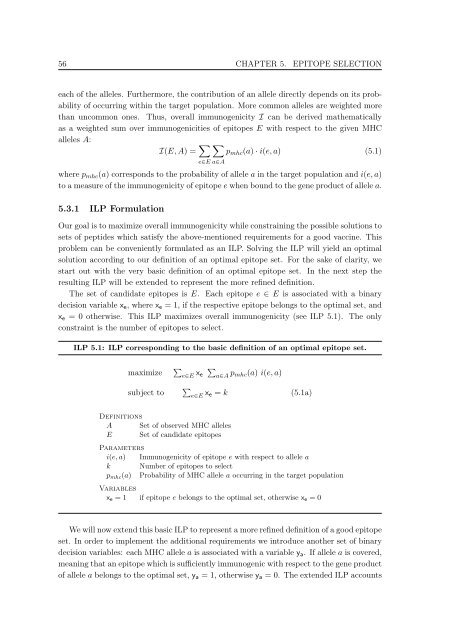New Approaches to in silico Design of Epitope-Based Vaccines
New Approaches to in silico Design of Epitope-Based Vaccines
New Approaches to in silico Design of Epitope-Based Vaccines
Create successful ePaper yourself
Turn your PDF publications into a flip-book with our unique Google optimized e-Paper software.
56 CHAPTER 5. EPITOPE SELECTION<br />
each <strong>of</strong> the alleles. Furthermore, the contribution <strong>of</strong> an allele directly depends on its probability<br />
<strong>of</strong> occurr<strong>in</strong>g with<strong>in</strong> the target population. More common alleles are weighted more<br />
than uncommon ones. Thus, overall immunogenicity I can be derived mathematically<br />
as a weighted sum over immunogenicities <strong>of</strong> epi<strong>to</strong>pes E with respect <strong>to</strong> the given MHC<br />
alleles A:<br />
I(E, A) = <br />
pmhc(a) · i(e, a) (5.1)<br />
e∈E a∈A<br />
where pmhc(a) corresponds <strong>to</strong> the probability <strong>of</strong> allele a <strong>in</strong> the target population and i(e, a)<br />
<strong>to</strong> a measure <strong>of</strong> the immunogenicity <strong>of</strong> epi<strong>to</strong>pe e when bound <strong>to</strong> the gene product <strong>of</strong> allele a.<br />
5.3.1 ILP Formulation<br />
Our goal is <strong>to</strong> maximize overall immunogenicity while constra<strong>in</strong><strong>in</strong>g the possible solutions <strong>to</strong><br />
sets <strong>of</strong> peptides which satisfy the above-mentioned requirements for a good vacc<strong>in</strong>e. This<br />
problem can be conveniently formulated as an ILP. Solv<strong>in</strong>g the ILP will yield an optimal<br />
solution accord<strong>in</strong>g <strong>to</strong> our def<strong>in</strong>ition <strong>of</strong> an optimal epi<strong>to</strong>pe set. For the sake <strong>of</strong> clarity, we<br />
start out with the very basic def<strong>in</strong>ition <strong>of</strong> an optimal epi<strong>to</strong>pe set. In the next step the<br />
result<strong>in</strong>g ILP will be extended <strong>to</strong> represent the more ref<strong>in</strong>ed def<strong>in</strong>ition.<br />
The set <strong>of</strong> candidate epi<strong>to</strong>pes is E. Each epi<strong>to</strong>pe e ∈ E is associated with a b<strong>in</strong>ary<br />
decision variable xe, where xe = 1, if the respective epi<strong>to</strong>pe belongs <strong>to</strong> the optimal set, and<br />
xe = 0 otherwise. This ILP maximizes overall immunogenicity (see ILP 5.1). The only<br />
constra<strong>in</strong>t is the number <strong>of</strong> epi<strong>to</strong>pes <strong>to</strong> select.<br />
ILP 5.1: ILP correspond<strong>in</strong>g <strong>to</strong> the basic def<strong>in</strong>ition <strong>of</strong> an optimal epi<strong>to</strong>pe set.<br />
maximize <br />
e∈E xe<br />
subject <strong>to</strong><br />
Def<strong>in</strong>itions<br />
A Set <strong>of</strong> observed MHC alleles<br />
E Set <strong>of</strong> candidate epi<strong>to</strong>pes<br />
<br />
a∈A pmhc(a) i(e, a)<br />
<br />
e∈E xe = k (5.1a)<br />
Parameters<br />
i(e, a) Immunogenicity <strong>of</strong> epi<strong>to</strong>pe e with respect <strong>to</strong> allele a<br />
k Number <strong>of</strong> epi<strong>to</strong>pes <strong>to</strong> select<br />
pmhc(a) Probability <strong>of</strong> MHC allele a occurr<strong>in</strong>g <strong>in</strong> the target population<br />
Variables<br />
xe = 1 if epi<strong>to</strong>pe e belongs <strong>to</strong> the optimal set, otherwise xe = 0<br />
We will now extend this basic ILP <strong>to</strong> represent a more ref<strong>in</strong>ed def<strong>in</strong>ition <strong>of</strong> a good epi<strong>to</strong>pe<br />
set. In order <strong>to</strong> implement the additional requirements we <strong>in</strong>troduce another set <strong>of</strong> b<strong>in</strong>ary<br />
decision variables: each MHC allele a is associated with a variable ya. If allele a is covered,<br />
mean<strong>in</strong>g that an epi<strong>to</strong>pe which is sufficiently immunogenic with respect <strong>to</strong> the gene product<br />
<strong>of</strong> allele a belongs <strong>to</strong> the optimal set, ya = 1, otherwise ya = 0. The extended ILP accounts

















